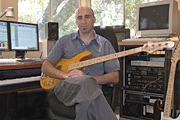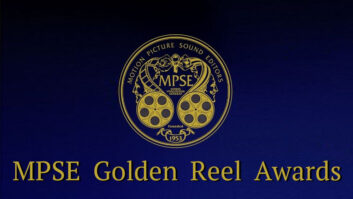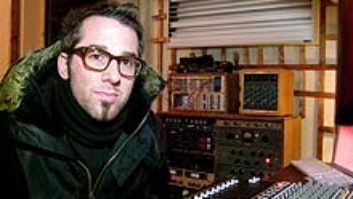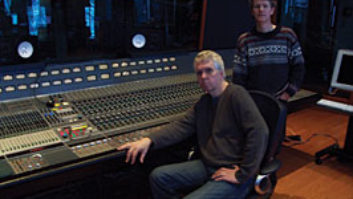
Surrounded by compuers and racks of gear: Joel Goodman in his L.A. studio
Great catastrophes often produce profound change. They can also create subtle curves. Joel Goodman, a native New Yorker who experienced 9/11 up close and personal, had to keep working while the ashes settled, even though his studio — located just blocks from Ground Zero — was off limits. He was, however, able to yank out his Yamaha 02R and haul the console back to his apartment a few blocks north. Using synths and samplers to write at home, Goodman continued to produce music for television and independent film projects, and — necessity being the mother of invention — decided to change his work method and track and mix entirely within the computer. Today, Goodman lives with his family and a coterie of computers in the greater Los Angeles area.
“I still have my studio in Manhattan,” he says. “It’s by the Trade Center site. When 9/11 went down, I had to schlep some of my gear back to our apartment. That’s when I decided to pick up a Digidesign 1622 interface. Now I have a Roland 1080 that I use for a click and it’s the only synth I turn on! I’m astounded with the number and quality of soft synths and samplers on the market.”
An established jingle writer and producer, Goodman shifted over to scoring independent films and television programs several years ago. He recently re-scored the 1966 film To Be Alive!, which was directed by Francis Thompson. “It’s a tremendous project and was the inspiration for the IMAX phenomenon,” he explains. “We cut orchestral tracks over in Abbey Road, and then added soloists in New York.
the Abbey Road session for Goodman’s re-scoring of To Be Alive!
“Working at Abbey Road Studio A was thrilling, of course, and the orchestra blew me away,” he continues. “I’ve done lots of orchestral dates in New York with great players, but the London group came in and had a sound that I hadn’t heard before. They functioned as a single unit in a way that I’d never experienced before. We recorded the entire session in 5.1 into Pro Tools|HD running 24/96 — a big tower of gear. The microphone collection is remarkable. I was told they have something like 18 Neumann M50s, perhaps the largest single collection in the world. I’m reasonably sure we used those on the Decca Tree and as room mics, as well.”
A number of films Goodman has scored are currently making the rounds at film festivals. One of them, The Forgotten, recently picked up the Best Feature award at the Sedona International Film Festival. He is also in his second season of scoring the weekly series Family Plots, which he describes as a real-life Six Feet Under show, for the A&E network; a second season of Dog the Bounty Hunter on A&E; and he scored Happy to Be Nappy, an Emmy-winning show on HBO.
On the day we spoke, Goodman had just purchased a dual 2GHz Mac G5, the fourth computer in his retooled studio. “All four computers have their own audio systems,” says Goodman. “The new G5 will run Digital Peformer under MAS. I have a MOTU 828 Mark II interface for it, and I’ll also be picking up a MOTU MTP A/V MIDI patchbay.” A longtime Digital Performer user, Goodman says that once he’s able to make an accurate assessment of the horsepower demands that Digital Performer places on the G5, he’ll run some Native Instruments plug-ins on it, as well, provided that the soft synths don’t comprimise its effectiveness as a MIDI sequencer and tracking environment.
Goodmman also runs Pro Tools MIX 3 on a G4 operating under OS 9. “The G4 will be my final destination for all audio,” he explains. “With three Farm cards, I’ve got plenty of processing power, and that lets me apply all of the reverbs and effects that I need. I also have Access Virus and some other soft synths on the G4, but it’s primarily a recording and mixing station.”
Synching audio to video has proven relatively simple in his new setup. Goodman uses Final Cut Pro when he’s working in Pro Tools, or if he’s scoring in Digital Performer, Quicktime movies. “I have a separate monitor for video, but for the most part, I simply use the small onscreen window within Pro Tools. In addition to the two 19-inch flat-panel monitors I currently own, I plan on picking up a third. One will be dedicated to Pro Tools and a pair will work with Digital Performer.
“The real advantage of working with video in Pro Tools, rather than Digital Performer, is that Pro Tools lets you quickly lay back a Quicktime movie with the audio you’ve created,” he adds. “As it turns out, though, I may have to run video on both the G4 and G5 because I can’t type in a bar/beat location in Digital Performer and have Pro Tools locate it immediately. It’s a bit redundant to run picture on both computers, but I need to spot quickly and it makes sense to do so within Digital Performer. For the time being, I’ll have separate drives running video on each computer. In the past, I’ve dropped a composite of audio and video to VHS, but that’s way too cumbersome for the way people like to work these days. Speaking of tape, I have a DA-88 recorder and a DAT machine, but I haven’t turned either of them on in at least two years!”
Working with a multiple computer setup requires a clear division of labor. Although Goodman is interested to see whether the G4 — his TDM computer — will be able to handle an instantiation of MOTU’s MachFive and perhaps a Native Instruments Kontakt sampler in addition to Pro Tools, he is prepared to pull back if its processor becomes overly taxed. He’d much rather continue to add computers than overburden any one of them.
“I also have two Pentium 4 PCs,” he interjects. “One of them is dedicated to GigaStudio. I’ve got a Dakota card in that computer running Lightpipe into my G4, as well as MIDI. This machine has 250 gigabytes of space and can access up to 64 channels of MIDI. The second PC runs Steinberg’s V Stack application. It’s the central host for all of my VST instruments. I love the East West Symphonic Orchestra, for example, and it lives on this computer.”
As it stands, Goodman uses three interfaces in his four-computer setup. The 1622 he bought shortly after 9/11 brings in audio from his Kurzweill K2600 and Roland JV1080, plus all of the soft synth data that he’ll create on the G5. He also has a Digi 882 that’s used to monitor voice-over tracks and an ADAT Bridge that accepts audio from both PCs. “I know, it’s a bit cumbersome. I plan on slimming things down in the near future!”
For many of his projects, Goodman replaces orchestral mockups — something he’s quite good at — with live players. When necessary, he leaves sampled performances intact. “It’s important for me to have great orchestral samples, and as I said, I’m really putting the East West Symphonic Orchestra through the paces these days. They recorded the orchestra with a lot of hall on the instruments, but I don’t mind it at all. I simply back off the reverbs I’m using.
“I tend to go back to some of my old libraries for woodwinds, though. It’s funny, the way that close-miking and high sampling rates seem to have brought woodwinds, in particular, into an extremely tight focus. I actually prefer the way the winds from my old Roland library lie in a track at times. I also find myself using winds from the old Miroslov and Advanced Orchestra libraries.”
Although he’s comfortable mixing quick turnaround projects on his own, Goodman prefers working with another set of ears whenever possible. One of his longtime compadres, Lawrence Manchester, accompanied him to London for the To Be Alive! scoring and mix sessions. A former staff engineer at both Avatar and Manhattan Center in New York, Manchester is currently a freelance engineer. “We mixed all of the orchestral cues in 5.1 at Abbey Road,” says Goodman. “There was also a package of smaller band pieces that we mixed at North Pole Studios, a private room in London that’s owned by Steve McGlaughlin. Steve’s done a lot of work with Michael Kamen, Elliot Goldenthal and other film composers.”
The sands of Malibu may be a cultural divide from the sidewalks of SoHo, but Goodman walks comfortably down both paths. “I go back to New York every four to six weeks; most of my work still comes from the East Coast, and I have an assistant, David Bramfitt, who works full time for me in the city. But I had a meeting yesterday with an air conditioning guy and I’m getting ready to soundproof the room I built onto my garage out here. I’ve got more opportunites [in L.A.] to work in film and television. Primarily, though, the move was based on a desire to change our lifestyle.”
Gary Eskow is a contributing editor to
Mix.




